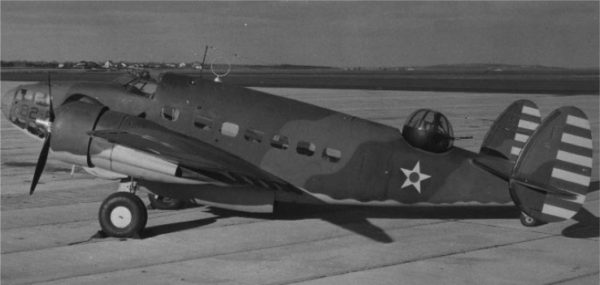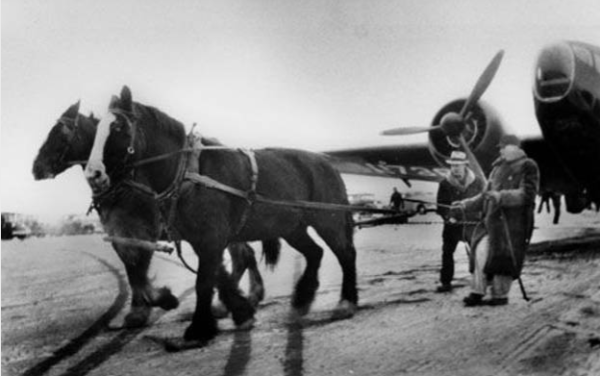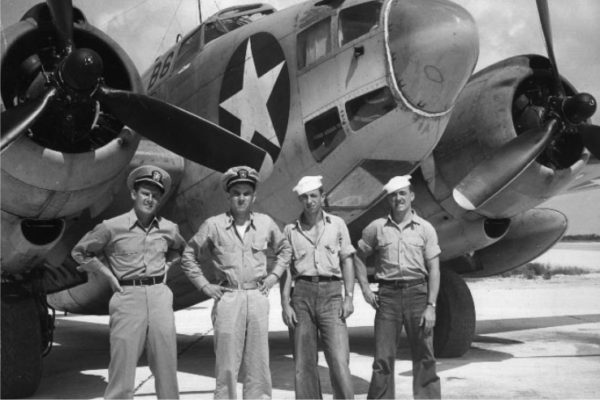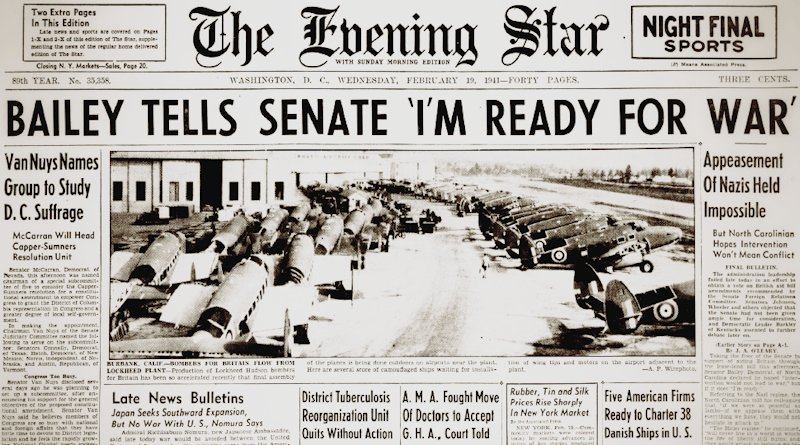World War II Chronicle: February 19, 1941
Click here for TODAY’S NEWSPAPER
On the front page we see rows of Lockheed Hudson twin-engine bombers awaiting installation of their wing tips at Lockheed’s Burbank, Calif. plant (which is now the site of a water treatment facility). You may not have heard much about this plane, but it recorded several “firsts” of World War II: on Oct. 8, 1939 over Denmark, a Royal Air Force Hudson accounted for the first kill of an Axis warplane from a plane based in the United Kingdom. An hour before Pearl Harbor is attacked, a Royal Australian Air Force Hudson sinks a Japanese transport off Malaya for the first Allied victory in the Pacific. Near Newfoundland on March 1, 1942, a U.S. Navy PBO-1 Hudson crew scores the first American victory over a German submarine of the war.

In August, another RAF Hudson receives the unique distinction of being the first airplane to “capture” a submarine. Nearly 3,000 Hudsons were produced during the war. It is interesting to note that while the government disclosed the numbers of aircraft produced last month (see “1,036 U.S. Planes Delivered in January” on the front page), they lumped models destined for Britain in with the U.S. Armed Forces.

But before they can hunt enemy subs, these planes have to depart the “neutral” United States. This process involves flying from Burbank to a new airport constructed by Lockheed for these transfers at Pembina, North Dakota where the plane is taxied to the U.S.-Canadian border. The planes are then towed into Canada either by vehicle or horse so the Hudsons are legally transferred to the Canadians and the pilots take off again.
VP-82

Returning to Patrol Squadron 82, the outfit that sank the first German sub from the air… Ensign William Tepuni is the Hudson pilot who sunk U-656. While we can’t track down records of the rest of the crew, we do know that Tepuni received his first Distinguished Service Cross for his U-boat victory and a second when he was killed by Japanese anti-aircraft fire during a bombing attack on Cebu City in the Philippines on March 21, 1945. The NAMTRAGRUDET1Naval Air Maintenance TRAining GRoUp DETatchment — for those who enjoy a good acronym building at Naval Air Station (NAS) Jacksonville, Fla. is named in his honor. Two weeks later, VP-82 crews sunk another enemy sub — U-503 — this time in a PBY Catalina.
VP-82 flew a lot of planes. And had a lot of names. And even more duty stations. A quick run-down: Established as VP-20 in Sept. 1938 and flew Consolidated P2Y-3 seaplanes out of NAF Seattle. Re-designated VP-61 in January 1941 and transferred to Alameda, Calif. Transferred again in June to Norfolk, Va. Re-designated VP-82 in July and transferred to NAS Floyd Bennett Field, N.Y. Sent back to Norfolk in October, but quickly relocated to NAS Quonset Point, R.I.
The Dictionary of American Naval Aviation Squadrons (Volume 2) features an excerpt from a 1941 squadron newsletter: “It is believed that this squadron has the distinction of completing the greatest number of reassignments of aircraft in the shortest time. From the period 29 March to 26 July (less than four months) four complete new assignments of air-planes, including spare parts, have been accomplished. The models assigned included P2Y-3, PBY-3, PBY-4 and PBY-5. Up to date, no repeat on any one plane has resulted.” Beginning in October, VP-82 pilots began ferrying Lockheed Hudsons from the Burbank plant to Norfolk and the squadron switched to their fifth plane.
Before they could get settled in, the squadron detached 12 aircraft to Argentia to protect convoys, patrol the harbor, and search for enemy U-boats. Crews berthed in seaplane tenders until barracks were ready at the new air station in May 1942. In September, they switched out their Hudsons for the Lockheed PV-1 Ventura. The squadron bounced around the East Coast throughout the war and sent detachments to other bases across Florida, the Bahamas, Cuba, Brazil, Trinidad, and Ascension Island.
Incidentally, Tepuni — by then a lieutenant commander — flew a Ventura on his last mission. As there appear to only be two planes in the raid on the Cebu City wharf, and Tepuni wasn’t shot down until after his attack run, it’s entirely possible that his crew sunk the Japanese midget sub that was listed as destroyed on their March 21, 1945 sortie.
While VP-82 crews were surely happier with their Caribbean duty assignments, they netted all three victories of their victories off the Newfoundland coast: Tepuni’s kill on March 1, U-503 was sunk two weeks later, and U-174 on April 27, 1943. While the first two subs never sunk a vessel, U-174, commanded by Oberleutenant Wolfgang Grandefeld, had sunk five Allied ships and over 30,000 tons.

Pilot Lt. (j.g.) Thomas Kinaszczuk was decorated with the Navy Cross, and as the convoy he and his crew saved was bound for the Russian port of Murmansk, he also received the Soviet Union’s Order of Glory. Later in the war, his plane developed engine problems while his crew was carrying sensitive cargo from South America to Europe. He skillfully ditched in the ocean, and all crew members were able to escape in life rafts. They were rescued after five days at sea. He flew for Pan American World Airlines after the war, retiring as a Captain of 747 jets.
Debt then and now
Pres. Roosevelt signed the Public Debt Act, raising the national debt ceiling to $49 billion. Adjusting for inflation it would take our 117th Congress about 56 days to spend that money, which is roughly $1 trillion in 2021 dollars.2Going off reported Fiscal Year 2020 federal spending at $6.55 trillion, that means Congress spends a trillion dollars every 55 days, 17 hours, 24 minutes, and 16.48 seconds And we aren’t mobilizing for a global war.
Not to drill too deeply into economics, but it is worth mentioning that 80 years ago our national debt was just 40% of our gross domestic product. Today’s official debt, not accounting for unfunded liabilities, is 140% of our GDP.
Evening star. (Washington, D.C.), 19 Feb. 1941. Chronicling America: Historic American Newspapers. Lib. of Congress.
https://chroniclingamerica.loc.gov/lccn/sn83045462/1941-02-19/ed-1/
